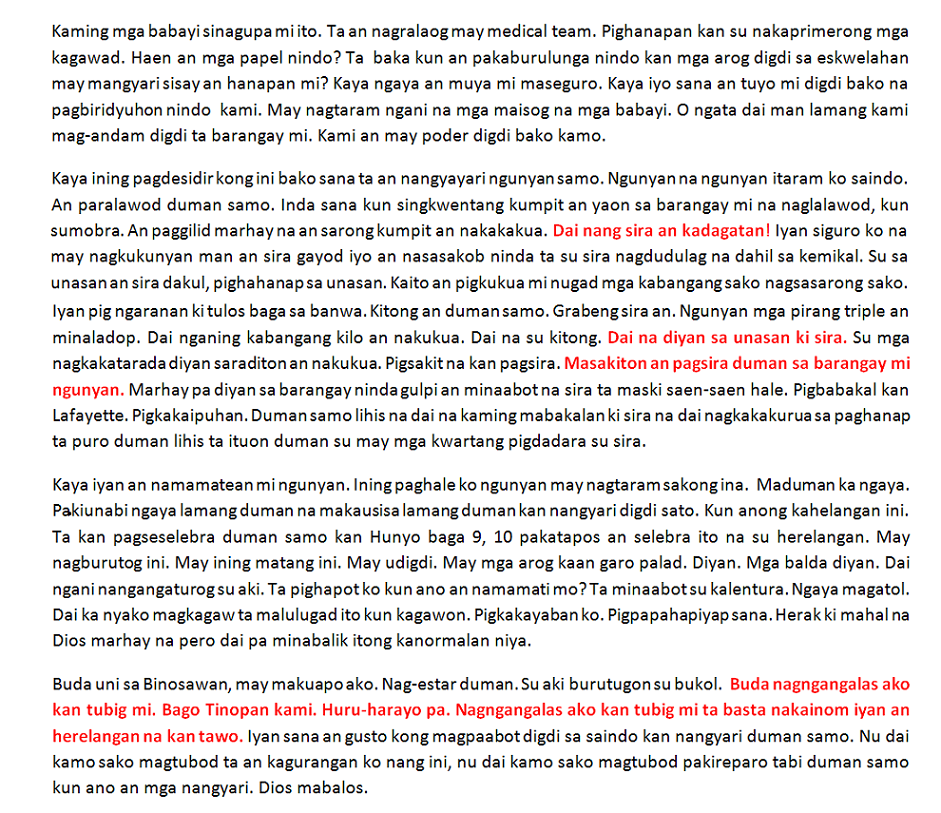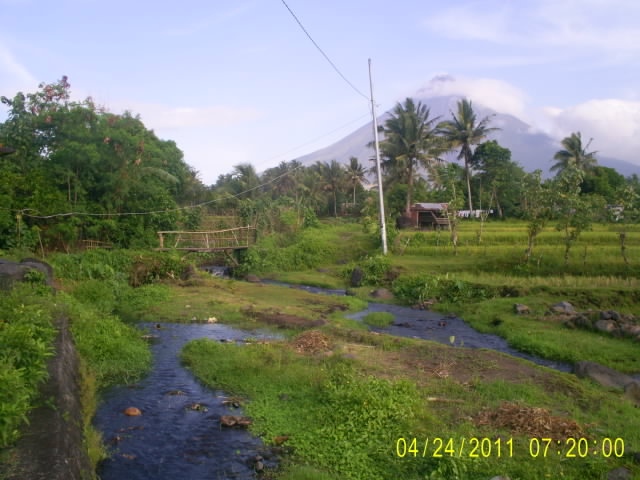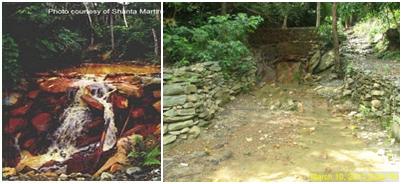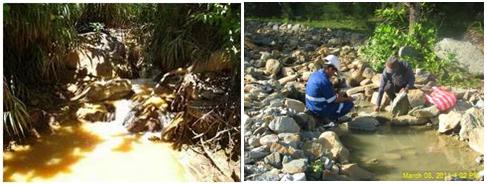
Protesters shout slogans opposing the reopening of Lafayette mining during a rally in front of the South Korean Embassy in Manila , June 11. / AP-Yonhap
By Kevin Griffith
The Korea Times
06-15-2008 16:09
A picture appeared on the front page of The Korea Times on June 12 concerning a protest in front of the South Korean Embassy in Manila over a planned reopening of a mining operation on Rapu-Rapu Island , the Philippines.
This article is to inform the Korean public about why people are protesting against Korean chaebol which are trying to reopen the mining operation, and also expose the ongoing humanitarian and ecological crisis on the island.
Earlier in April, Korean corporations ― LG International and Korean Resources Corp. (Kores) ― gained majority control of an Australian firm Lafayette Philippines Inc. (LPI).
LPI has been operating a highly controversial Polymetallic Mining Project on the once pristine island of Rapu-Rapu in the Republic of the Philippines .
LG and Kores have taken control of the operation; therefore, the details of this affair are now the business of the Korean people.
Rapu-Rapu is no longer pristine because the environmentally damaging practices of mining have incurred severe ecological damage to Rapu-Rapu's ecosystem. In the process of mining, LG and Kores use toxic chemicals to retrieve the minerals.
In November 2005, LPI was found liable for many damaging cyanide and mine tailings spills which resulted in massive fish kills, environmental destruction, community displacements, human rights violations and livelihood loss to the local people.
While I was there, I saw the fish kills with my own eyes. I even saw a dead whale shark there in 2003. I served as an American Peace Corps volunteer and lived on Rapu-Rapu Island from 2002-04.
I lived and worked hand-in-hand with the 20,000-plus Rapu-Rapuhon and personally know the hardships the local people have faced.
The local people were given false promises from LPI that their lives would be improved by allowing a mine to remove the valuable gold, copper, silver & zinc deposits.
The exorbitant mining profits resulting from the mining operation have gone to LPI and the Philippine government; meanwhile, the fisher folk are losing their livelihood and the local population is losing their most important source of protein, fish.
When I visited the island during Christmas festivities last December 2007, the Rapu-Rapuhon could not eat fish caught from the sea because the risk of illness was too great. People lived in fear of their food, and the fishermen couldn't sell their fish on the mainland.
The local Catholic Church has a sign on the steeple that says, `` Lafayette thinks this is a hoax. Rapu-Rapu is suffering for real.'' Children can be seen naked on the streets, dogs with mange run wild and the local high school's computer lab remains damaged from a super typhoon; meanwhile, LPI profits by exploiting Rapu-Rapu Island 's minerals.
Kalikasan, the people's network for the environment, said that the Mines and Geosciences Bureau (MGB) ordered LPI to pay 134 million peso (3.1 billion won) to rehabilitate the damages caused due to the mining. However, I have been unable to find any report confirming this payment has ever been made.
Kalikasan reports, `` Lafayette 's income during its operation was estimated at 3.487 billion peso (80.94 billion won).'' This is just another case of a mining operation being more concerned about profits and shareholders than environmental and social responsibility.
A press release from Kalikasan's Web site quotes their national coordinator Clemente Bautista as saying, ``There is no reason to continue the Lafayette mining project. Its three-year operation in Rapu-Rapu Island has brought enormous environmental destruction, community displacements, human rights violations and livelihood loss to the local people.''
An LG press archive states that once Rapu-Rapu operations stabilize, the Korean firm and Lafayette will be embarking on other mining projects in the Philippines.
Are we to believe that the catastrophic impact of mining on Rapu-Rapu Island is going to change now that Korea 's LG is in control? Bikolanos have been protesting LPI's mining operation for over six years now; I'm afraid that operations will not stabilize.
There has been a long history of exploitation of the Rapu-Rapu people, which dates back to Japanese occupation during World War II. The Imperial Japanese had a base on the island because it provided a valuable lookout point for the Albay Gulf.
The locals told me that the Japanese would rape local women and sometimes shoot them and their families. They employed forced labour during the occupation to plunder the minerals from the island.
Now, LPI is profiting from the purchase and exploitation of land on the island; meanwhile, the local population once again suffers.
Who should be responsible for the ecological and humanitarian catastrophe brought on by LPI's mining operation?
The Australian investors apparently feel comfortable selling their stake, taking their profits, and washing their hands of the whole affair.
Now, LG and Kores are the major shareholders; therefore, they are responsible. They have made a big mistake and underestimate the veracity and the fortitude of the Filipino people.
LPI must pay the fines and reparations demanded by the Philippines and stop the mining operation on Rapu-Rapu Island indefinitely. People matter, even if those running the operation consider these people to be nothing more than ``peasants,'' The people of Rapu-Rapu Island want their livelihood, food source, and island returned.
If you're interested in learning more about this crisis, watch Greenpeace's ``Undermining Paradise'' at http://kr.youtube.com/watch?v=EnVg3nywXNQ.
Kevin Griffith is currently working as an English teacher trainer at the Gyeonggi-do Institute for Foreign Language Education (www.gifle.go.kr) near Pyeongtaek, Gyeonggi Province . He worked as an English teacher trainer with the U.S. Peace Corps in the Philippines from 2002-04. He can be reached at intrepidkev@yahoo.com
































































































































No comments:
Post a Comment